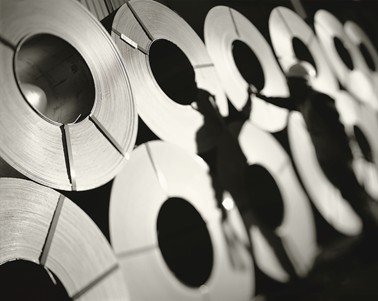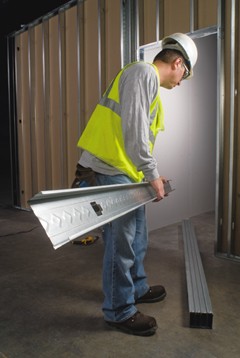 By Greg Ralph, ClarkDietrich Building Systems
By Greg Ralph, ClarkDietrich Building Systems
Cold-formed steel has come a long way since it was advertised for use in portable iron houses for the California Gold Rush in 1849. Its use in construction was limited back then, but it was an option nonetheless. The material, like many other aspects of modern life, evolved alongside the industrialization of North America. It was even on display by way of steel-framed homes and metal roofing panels in the 1933 Chicago Worlds Fair. This highly public demonstration coupled with a smattering of successful steel-built structures erected throughout the United States, are part of what helped the material gain ground in the building industry.
The growing interest in integrating cold-form steel into construction practices prompted the first design standards for the material, a critical component to the health and safety of any built structure. These were published in 1946 when the American Iron and Steel Institute (AISI) issued the first edition of its Specification for the Design of Light Gage Steel Structural Members.
Notably it was this era that also gave rise to the use of gypsum. By 1955, in fact, half of all new homes were built using gypsum wallboard while the other half used gypsum lath and plaster according to the Cold-Formed Steel Engineers Institute. It was not long before gypsum companies, whose gypsum products were naturally fire resistant, commenced efforts to create a non-combustible substrate that could support gypsum board. Through some trial and error, the gypsum board and steel stud industries together came up with the self-drilling screw which made way for easy-to-build non-combustible partitions that was a boon for the gypsum, steel framing and even tool industries. The rest is history so to speak. Contractors now use cold-formed steel studs along with gypsum board to create fire-resistant wall assemblies as well as dry wall systems. Such efforts have for decades gone hand in hand to the benefit of small and large buildings and continue on into today’s more sophisticated building systems approach to construction.
 As the market for steel framing grew strong in the mid-1900s, so too did the need for improved standards specific to cold-formed steel products. Enter ASTM C645 Standard Specification for Nonstructural Steel Framing Members first published in 1970 and ASTM C955 Standard Specification for Load-Bearing (Transverse and Axial) Steel Studs, Runners (Tracks), and Bracing or Bridging for Screw Application of Gypsum Panel Products and Metal Plaster Bases in 1981. Though these guidelines attempted to define the standard properties of nonstructural and structural framing members, they were skeletons of what exist today. ASTM C645 was loose at best, offering no provisions for any protective coating on the steel sheet. It did not require any marking or identification of the members. There was no screw or spinout procedure. There were no performance requirements for alternative thickness products and no reference to limiting heights. As for ASTM C955, these standards specified that members were to be made from steel, yet there was no reference to any particular steel specification to which they were required to conform. That was then.
As the market for steel framing grew strong in the mid-1900s, so too did the need for improved standards specific to cold-formed steel products. Enter ASTM C645 Standard Specification for Nonstructural Steel Framing Members first published in 1970 and ASTM C955 Standard Specification for Load-Bearing (Transverse and Axial) Steel Studs, Runners (Tracks), and Bracing or Bridging for Screw Application of Gypsum Panel Products and Metal Plaster Bases in 1981. Though these guidelines attempted to define the standard properties of nonstructural and structural framing members, they were skeletons of what exist today. ASTM C645 was loose at best, offering no provisions for any protective coating on the steel sheet. It did not require any marking or identification of the members. There was no screw or spinout procedure. There were no performance requirements for alternative thickness products and no reference to limiting heights. As for ASTM C955, these standards specified that members were to be made from steel, yet there was no reference to any particular steel specification to which they were required to conform. That was then.
The current editions of C645 and C955 are much more robust. They now specify ASTM A1003 as the steel requirement for mechanical and physical properties of the steel that must be used to manufacture framing members. In addition, C645 now outlines coating requirements for products manufactured according to the standard. It also includes a detailed penetration and spinout test for stud and hat furring channel products. The standard further discusses alternative thickness EQ products and when it is permitted to use these materials. Marking and identification requirements, manufacturing tolerances, and illustrations for where and how to measure them are also detailed within the standard.
Both ASTM C645 and ASTM C955 are part of a code synchronization effort within the AISI Committee on Framing Standards. This initiative is intended to ensure that AISI and ASTM requirements are always aligned so as to avoid any confusion. As such, users of the ASTM standards will see references within C645 and C955 pointing to the relevant AISI documents.
 Among the biggest advancements to cold-formed steel members in recent years is the change in paragraph 9.2 of ASTM C645. This section now permits the use of what have become known as EQ studs or EQ thickness studs. Improvements in manufacturing technology and a redesign of the basic stud profile along with changes in the strength of steel used to manufacture EQ thickness studs resulted in products manufactured to a thickness less than the ASTM specified 18-mil, but which attained the same or greater limiting heights as standard thickness members. In addition, the members have better screw shear and pullout values per higher strength steels used in the manufacturing of the EQ thickness studs. Plus they are light weight which makes them easier for contractors to handle and install. For these reasons, most manufactured interior drywall studs are now EQ thickness studs, thanks to this single change in ASTM standards.
Among the biggest advancements to cold-formed steel members in recent years is the change in paragraph 9.2 of ASTM C645. This section now permits the use of what have become known as EQ studs or EQ thickness studs. Improvements in manufacturing technology and a redesign of the basic stud profile along with changes in the strength of steel used to manufacture EQ thickness studs resulted in products manufactured to a thickness less than the ASTM specified 18-mil, but which attained the same or greater limiting heights as standard thickness members. In addition, the members have better screw shear and pullout values per higher strength steels used in the manufacturing of the EQ thickness studs. Plus they are light weight which makes them easier for contractors to handle and install. For these reasons, most manufactured interior drywall studs are now EQ thickness studs, thanks to this single change in ASTM standards.
Equivalent coatings are of course another huge step forward for the industry and are now being used on ASTM C645 interior framing members. When applied to steel sheet with a zinc-based coating, EQ coatings have demonstrated better corrosion protection than the traditional G40 coating. ASTM C645 requires members to have either a G40 hot-dipped coating or a coating that provides equivalent corrosion resistance; however, the standard does not indicate how to determine equivalent corrosion resistance.
It is possible to demonstrate equivalent corrosion resistance by conducting an apples-to-apples salt-spray comparison test such as is outlined in ASTM B117-09. This procedure tests an EQ-coated specimen next to one with a hot-dipped galvanized coating until the specimen with the known G40 coating fails. Another way a manufacturer can demonstrate compliance with the equivalent corrosion resistance provision of ASTM C645 is to use a code compliance report issued by an independent IAS accredited agency. This third-party report would further attest that the EQ coated member meets the requirements of the standard.
Needless to say, cold-formed steel has been an integral material in the growth of sophisticated building design. Manufacturers have become adept at meeting the intent of standards and innovating beyond them, such as with EQ thickness studs and EQ coatings. As a result contractors are now working with lighter, stronger studs. So what’s next? Energy efficient studs? Possibly. Whatever the future holds for cold-formed steel studs, one thing is certain: manufacturers will continue to evolve to improve processes and provide labor savings through products that are easier to handle and install. Stay tuned as advancements in cold-formed steel framing members are sure to come.